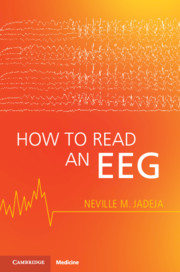Book contents
- How to Read an EEG
- How to Read an EEG
- Copyright page
- Dedication
- Contents
- Figure Contributions
- Foreword
- Preface
- How to Read This Book
- Part I Basics
- Part II Interpretation
- Chapter 9 Approach to EEG Reading
- Chapter 10 Background
- Chapter 11 Foreground (How to Describe an Abnormality)
- Chapter 12 Common Artifacts
- Chapter 13 Normal Variants
- Chapter 14 Sporadic Abnormalities
- Chapter 15 Repetitive Abnormalities
- Chapter 16 Ictal Patterns (Electrographic Seizures)
- Chapter 17 Activation Procedures
- Part III Specific Conditions
- Appendix How to Write a Report
- Index
- References
Chapter 9 - Approach to EEG Reading
from Part II - Interpretation
Published online by Cambridge University Press: 24 June 2021
- How to Read an EEG
- How to Read an EEG
- Copyright page
- Dedication
- Contents
- Figure Contributions
- Foreword
- Preface
- How to Read This Book
- Part I Basics
- Part II Interpretation
- Chapter 9 Approach to EEG Reading
- Chapter 10 Background
- Chapter 11 Foreground (How to Describe an Abnormality)
- Chapter 12 Common Artifacts
- Chapter 13 Normal Variants
- Chapter 14 Sporadic Abnormalities
- Chapter 15 Repetitive Abnormalities
- Chapter 16 Ictal Patterns (Electrographic Seizures)
- Chapter 17 Activation Procedures
- Part III Specific Conditions
- Appendix How to Write a Report
- Index
- References
Summary
Confirm the patient’s identity, age, state(s) of recording, and the presence of any skull defects. Confirm the technical parameters of including the filter settings, sensitivity, paper speed, and time base. Note the montage you are reading in and the calibration signal. Identify the background from the foreground. Describe the background based on symmetry, continuity, voltage, organization, variability-reactivity, and sleep architecture. Categorize the foreground components as cerebral activity or artifact. Describe cerebral activity based on its location (general or lateral), occurrence (sporadic or repetitive), and morphology (slow or sharp). Then categorize the activity as normal (normal variant) or abnormal. Decide if the abnormality is epileptogenic (associated with seizures) or ictal (ongoing seizure). Evolution is the hallmark of electrographic seizure activity. Remember that isolated changes in amplitude are not evolution. Look for the use of any provocation methods, such as hyperventilation and photic stimulation, and their effect on the EEG. Before you finish up, make sure you’ve looked at the single-channel EKG and the technologist’s log.
- Type
- Chapter
- Information
- How to Read an EEG , pp. 61 - 66Publisher: Cambridge University PressPrint publication year: 2021

